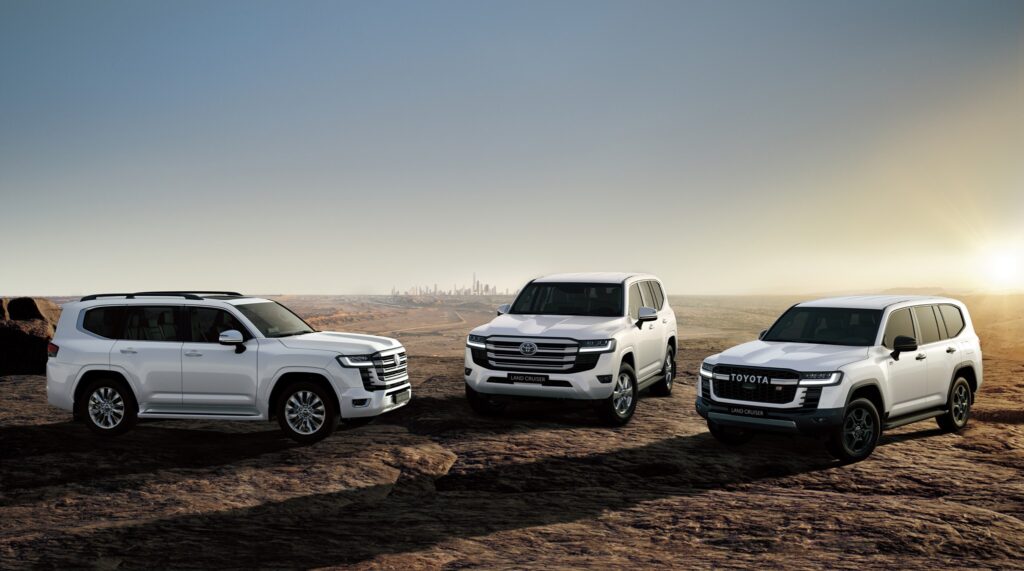
Photo credit: Toyota UAE
When one thinks of reliable, efficient, and innovative automobiles, Toyota is a name that readily comes to mind. The history of Toyota cars is a testament to the company’s enduring commitment to quality and innovation, spanning over eight decades of automotive excellence.
Early Beginnings (1930s-1940s)
The roots of Toyota’s automotive journey can be traced back to the 1930s when the company, originally known as the Toyoda Automatic Loom Works, embarked on the ambitious quest to manufacture automobiles. In 1936, Toyota unveiled its first prototype car, the Toyota Model AA, showcasing its early foray into the automotive industry. Following this milestone, Toyota Motor Co., Ltd. was established in 1937, marking the beginning of mass production of automobiles.
World War II and Post-War Resilience (1940s)
During World War II, Toyota, like many Japanese companies, shifted its focus to producing military vehicles and equipment to support the war effort. However, the war’s end brought significant challenges, including financial constraints. Nevertheless, Toyota persevered and resumed automobile production in 1947, signaling a determination to overcome adversity.
Land Cruiser and Sports 800 (1950s)
The 1950s saw the introduction of two iconic Toyota models that would leave a lasting mark on the automotive industry. First, there was the legendary Toyota Land Cruiser, celebrated for its ruggedness and exceptional off-road capabilities. Simultaneously, Toyota unveiled the Sports 800 in 1955, a compact sports car that showcased the company’s versatility in crafting diverse automotive offerings.
Corolla and Crown (1960s)
The 1960s witnessed the emergence of two influential models that would help define Toyota’s global reputation. The Toyota Corolla made its debut in 1966, swiftly becoming a best-seller worldwide. Its affordability, reliability, and fuel efficiency made it a favorite among consumers. Alongside the Corolla, the Toyota Crown exemplified luxury and prestige in the company’s lineup.
Environmental Initiatives (1970s)
In response to growing environmental concerns, Toyota introduced the Corolla with a catalyst-equipped engine in 1975. This pivotal move reflected Toyota’s dedication to reducing emissions and enhancing fuel efficiency, laying the groundwork for its future environmentally conscious endeavors.
Lexus and Camry (1980s)
The 1980s heralded two major developments for Toyota. In 1983, the luxury division Lexus was born, signaling Toyota’s ambition to challenge European luxury car manufacturers. The debut of the Lexus LS 400 in 1989 garnered acclaim for its quality and reliability. Concurrently, the Toyota Camry entered the scene as a popular midsize sedan, solidifying Toyota’s presence in the United States.
Hybrid Technology (1990s)
The turn of the millennium witnessed Toyota’s pioneering spirit in full swing. In 1997, Toyota unveiled the Prius, the world’s first mass-produced hybrid car. This groundbreaking innovation marked a significant leap towards more environmentally friendly vehicles and set the stage for hybrid technology’s global acceptance.
Global Expansion (2000s)
In the 21st century, Toyota continued its expansion across the globe. The company established manufacturing plants in various countries, including the United States, further solidifying its position in international markets. The Toyota Camry emerged as one of the best-selling cars in America, underscoring Toyota’s prominence in the U.S. automotive landscape.
Quality and Safety (2010s)
While Toyota’s reputation for quality remained strong, the late 2000s brought a series of recalls due to quality and safety concerns. Toyota responded with unwavering commitment, implementing rigorous quality control measures and re-emphasizing its dedication to safety and reliability.
Future Directions (2020s)
As of my last knowledge update in September 2021, Toyota was actively pursuing the development of electric and hydrogen fuel cell vehicles, as well as advancing its hybrid technology. The company continues to innovate and adapt to evolving trends in the automotive industry, ensuring it remains at the forefront of automotive excellence.
In conclusion, the history of Toyota cars is a rich tapestry of innovation, resilience, and a relentless pursuit of quality. From its early days as a loom manufacturer to its current status as a global automotive giant, Toyota’s journey serves as an inspiration to the industry and a testament to the power of unwavering commitment to excellence.


